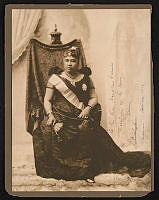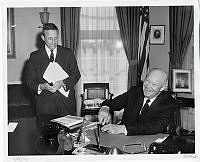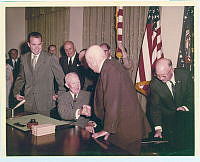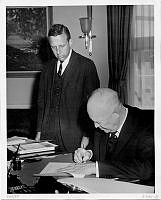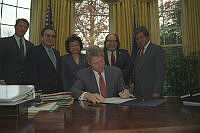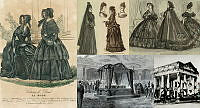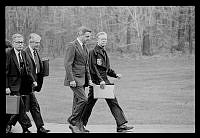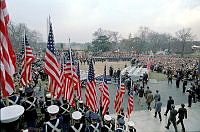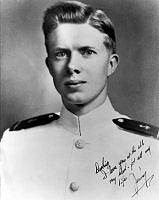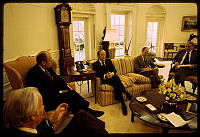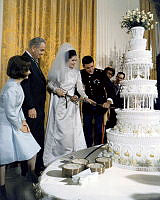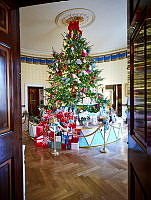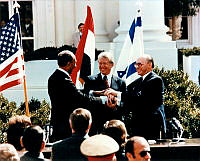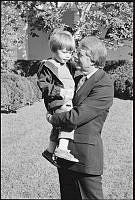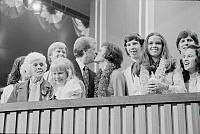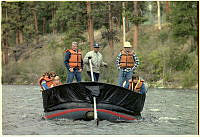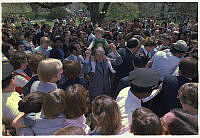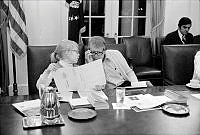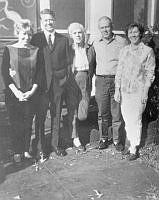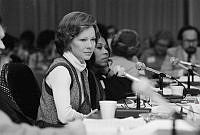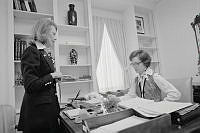Presidents and the Potomac
Copyright © June 1997 White House Historical Association. All rights reserved under international copyright conventions. No part of this article may be reproduced or utilized in any form or by any means, electronic or mechanical, including photocopying, recording, or by any information storage and retrieval system, without permission in writing from the publisher. Requests for reprint permissions should be addressed to books@whha.org
For the politicians, civil servants, and accompanying citizenry of the new federal government—freshly arrived in 1800 from comfortable, sophisticated Philadelphia—the young capital that sprawled along the banks of the Potomac was a disheartening scene. Dispersed among the woodlots and along the sparsely inhabited river shore, the city of Washington’s four-mile expanse was a scattering of fewer than four hundred brick and wooden houses; several government buildings stood in various stages of construction, cluttered with associated debris. The port town of Georgetown and the larger, thriving Alexandria lay beyond the capital’s planned limits.
The muddy landscape of the President’s House was just as deplorable as the rest of the city; John Adams—second president, but the first to occupy the White House—and his wife Abigail found workmen’s shanties, supply huts, and old kilns strewn about the grounds. For a fledgling democracy aspiring to project an image of a world power and rank with the great nations of Europe, Washington’s helter-skelter vista thus posed a challenge. After all, the Frenchman artist-engineer, Pierre L’Enfant, had planned this capital city with a grand design in the spirit of Europe’s eminent urban centers and gardens; much of his inspiration had come from Andre Le Notre, among the greatest landscape designers of all ages—the planner of the gardens of Versailles and the Tuileries.
In his design for Washington, L’Enfant had placed the President’s House on an elevation where it commanded a vista to the south. This view formed an axis that intersected a second axis that extended westward from the Capitol; for the crossing of these two axes—the site of the present-day Ellipse—he proposed an equestrian statue of George Washington. The view from the White House extended beyond this heroic memorial to the broad sweep of the upper Potomac estuary, where it was handsomely framed by a backdrop of Virginia hills.
A third significant axis—symbolizing the balance between the executive and legislative arms of the government—was Pennsylvania Avenue, which ran diagonally from the President’s House to the Capitol, on its own commanding site on Jenkins Hill. This avenue was to become the new republic’s major ceremonial thoroughfare. Today the great monumental triangle formed by the three axes that constitute the center of Washington reflects the genius of Pierre L’Enfant.
L’Enfant used to advantage the capital’s riparian location, cradled between the Potomac and the Eastern Branch, now the Anacostia River. His plan proposed an east-west waterway, the Washington Canal, to play a significant role in the commercial and aesthetic land-scape of the new capital. This canal would connect the Potomac with the Eastern Branch—now the Anacostia River—and run between the President’s House and the Washington memorial statue along the location of the present-day Constitution Avenue.

As a water route to the interior the Potomac River presented physical difficulties in various obstructions to navigation, which, though picturesque, required canals to bypass. One such spot was Great Falls, shown here in 1802 in an engraving by G. Beck and T. Cartwright.
Library of CongressThe origin of this canal was in part serendipitous, as it was to serve as a channel for Tiber Creek, a sluggish stream that flowed from the eastern side of the city and worked its way through tidal flats into the Potomac. Tiber Creek’s headwater was to the north of Jenkins Hill, and L’Enfant planned that it be engineered into a large cascade flowing to the base of the hill; his further scheme—in the spirit of Le Notre, who so skillfully used water in his designs—was that the canal would serve not only as a cross-city commercial and drainage facility but also as a picturesque waterway, with sailing craft and handsome bridges in the tradition of the canals of Venice.
The Residence Act of 1790, which designated the Potomac River as the site for the United States capital, was passed by Congress after some years of contention among competing cities. This legislation also provided that President George Washington select the capital’s specific location on the river somewhere between Conococheague Creek—a tributary fifty miles to the west of tidewater— and the Eastern Branch. Washington’s choice of a site at the beginning of the tidal Potomac, the river’s estuary, was a logical one. At the river’s head of navigation, it was accessible to ocean commerce and most convenient to the country’s principal north-south overland transportation route. At the same time, its distance from the Atlantic Ocean and the navigational problems for large warships that might attempt to ascend the river provided substantial security from foreign invaders.
George Washington was a native of the Potomac tidewater, and he loved the river. Historians note that it was with reluctance that he left Mount Vernon to serve in public or military office; he referred to Mount Vernon’s frontage on the river as “my door” where sea captains came to trade.
In December 1793 he wrote of his plantation:
“No estate in United States is more pleasantly situated than this. It lies in a high dry country 300 miles by water from the Sea and, as you will see by the plan, on one of the finest Rivers in the world. Its margin is washed by more than ten miles of tidewater; from the bed of which, and the innumerable coves, inlets, and small marshes, with which it abounds, an inexhaustible fund of rich mud can be drawn as a manure, either to be used separately or in a compost, according to the judgment of the farmer.”1
No estate in United States is more pleasantly situated than this. It lies in a high dry country 300 miles by water from the Sea and, as you will see by the plan, on one of the finest Rivers in the world.
So the river, in addition to being “well supplied with various kinds of fish at all Seasons of the year, and in the Spring with Shad, Herrings, Bass, Carp, Perch, Sturgeon, etc. in great abundance” all to satisfy the plantation’s food requirements, also played a role in his endeavors as a scientific farmer.2 In October 1785 he wrote that he planned to use quantities of the river’s mud on experimental plots to determine its productivity. He also provided for a system of crop rotation for his farms.
But for Washington the role of the Potomac went beyond the cherished precincts of his Mount Vernon. Travels to the westward reaches of the river in the campaigns of the French and Indian War and in his work as a young surveyor gave him a knowledge of the geography of the region. He conceived of the Potomac valley as a major transportation corridor that could unite the eastern seaboard with the interior of the continent. As early as 1759 he advocated a water highway route through the Alleghenies. Thomas Jefferson supported the corridor concept and in March 1784 wrote Washington: “Nature then has declared in favor of the Patowmac and through that channel offers to pour into our lap the whole commerce of the Western world.”3 That September, motivated by the belief that the development of such a commercial route west could prevent the loss of both the political allegiances and the trade of western settlers to European colonial powers in Canada and Louisiana, Washington led a month-long, six-hundred-mile expedition up the Potomac. A principal objective of the endeavor was to find the best route up the Potomac and over the Alleghenies to the Ohio River.
Washington’s exploration was a great success. Making full use of his authority as a revered leader of the Revolution, along with the chronicle of his trip he set forth a persuasive course of action: on his recommendation the Virginia and Maryland legislatures, also fired by the dreams of investors and merchants, moved quickly to authorize the Patowmack Company. By late summer 1785, with Washington as president, the company started to build a navigable passage intended initially to run between Washington and Cumberland. The company’s plan combined several devices: canals around the five most formidable Potomac barriers, including the rapids at Harpers Ferry and Great Falls; low-level dams to divert water into deepened channels or sluices; the widening and deepening of the river in some areas; and the removal of boulders in others. Connection to the Ohio was to be made by overland portage from the highest point of the Potomac that could be made navigable.4

George Washington envisioned the Potomac as a golden corridor between the American frontier, as it was then known, and the sea.
White House Collection/White House Historical AssociationRough, rocky, and shallow stretches through mountainous terrain were not the only impediments to navigation: under the Articles of Confederation the central government had no power to regulate commerce, and the differences between Virginia and Maryland laws hampered Potomac trade. In an effort to reconcile these differences, commissioners from the two states had met from time to time since 1777. Finally, when they met at Mount Vernon in March 1785, they were able to draw up an agreement that opened the Potomac to access and free usage by both states.5 Washington served as host at the Mount Vernon Conference, as the meeting has come to be known. He was not a commissioner and apparently took no direct part in the discussions, but his expressed interest in the river as a commercial artery, his manifest leadership attributes, and his Federalist inclinations give reason to believe that he exerted a certain political suasion in the discussions.
The ambience of Mount Vernon’s location on a bluff in the “high dry country,” with a fine panoramic view of the Potomac and the forested Maryland shore beyond, was healthfully superior to the environs of the President’s House in the new capital. The house was less than a mile from and only a few feet above the place where Tiber Creek made its lazy entrance to the Potomac. The Residence Act of 1790 specified that relocation of the capital take place by November 1, 1800. Washington therefore never lived there, but all of the succeeding presidents did; the official and personal lives, and in some instances the health, of all those who occupied the White House until several decades after the Civil War was adversely affected by the close proximity of the river and the Washington Canal.
The work of Louis Pasteur and other scientists who demonstrated the role of microorganisms in the transmission of diseases was nearly a century in the future. Researchers did not determine that the anopheles mosquito carried the microbe responsible for malaria until 1898, or understand the etiology of typhoid fever, cholera, and hepatitis until the turn of the century. Many decades earlier, though, medical practitioners and those engaged in public works believed that what was termed miasma, or the poisonous atmosphere emanating from swamps and putrid matter, was responsible for certain febrile diseases of summer. These early-day epidemiologists were not far off the mark. In 1816 Dr. James Ewell, a Washington physician and author of The Medical Companion, wrote that several types of fevers that occurred in August, September, and October were due to the action of heat on “noxious exhalations” from decaying matter and the vapors or gases that arose from swamps.6
In the context of those times, the age of Enlightenment, it is not surprising that Thomas Jefferson had empirical knowledge that living in the tidewater during the summer was not healthful. At the beginning of his presidency in 1801 he wrote his secretary of the treasury, Albert Gallatin:
“I consider it as a trying experiment for a person from the mountains to pass the two bilious months on the tidewater. I have not done it these forty years and nothing should induce me to do it. As it is not possible but that the Administration must take some portion of time for their own affairs, I think it best they select that season for absence. General Washington set the example of those two months; Mr. Adams extended them to eight months. I should not suppose our bringing back two months a ground for grumbling, but grumble who will, I will never pass those two months on tidewater.”7
These unhealthful conditions in the vicinity of the President’s House were exacerbated as the years wore on by a combination of political contentions and indifference.
In January of the same year Gallatin, writing to his wife, had expressed similar opinions on the tidewater environs of the White House: that any house built on the forest path called Pennsylvania Avenue would expose its wretched tenants to perpetual fevers. In his letter he went on to say that the city was almost a wilderness and the White House “stood unenclosed on a piece of waste and barren ground” separated from the capitol by an almost impassable marsh.8
These unhealthful conditions in the vicinity of the President’s House were exacerbated as the years wore on by a combination of political contentions and indifference; moreover, the severe silting from farmland development that was moving westward up the Potomac and its tributaries created additional swamplands and ideal mosquito breeding conditions at the mouth of Tiber Creek.
Unfortunately the canal that L’Enfant had devised to channel Tiber Creek into the Potomac became a political football. The first Washington Canal Company was incorporated in 1802, but federal appropriations were indecisive; Georgetown, Alexandria, and turnpike interests had jealous concerns that the canal would generate commercial competition by providing transport for farm goods across the city to oceangoing vessels on the Eastern Branch. It was necessary to charter a second company in 1809, so work on the waterway did not begin until 1810. Poor construction that used wood for the locks and lining quickly fell apart, and a storm destroyed one lock in 1811. The work was finally completed in James Madison’s administration, and the canal began operation in November 1815.
Like Jefferson and Gallatin, President Madison was wary of spending hot months in sickly tidewater regions. Nevertheless, in two years he spent only two months away from the capital. By the spring of 1813 he was ill with bilious fever, and his condition became so serious that in mid- June his doctors were concerned for his life. The political pressures from a congressional opposition hostile to the War of 1812 and his diplomatic appointments were unrelenting. A young Daniel Webster, then only a second-term congressman, strode from the Capitol to the White House and, even though “the President was in bed, sick of a fever—his night cap on his head,” a devoted Dolley by his side, pressed Madison with the contentious congressional resolutions. On another visit during the same period of political tension the unsympathetic Webster commented on Madison’s illness, “I did not like his looks any better than his Administration.”9

An early romantic view of the President's House from the Potomac River.
White House Collection/The White House Historical AssociationBy 1820, during James Monroe’s first term, the Washington Canal was usable only at high tide. Its maintenance had been neglected, and it held only a few inches of water. City fathers asked Congress for access to funds from the sale of publicly owned lots to drain the increasingly swampy area along the waterway. The lawmakers disregarded the request. Not all of the Potomac’s bank was swampland; early in his presidency John Quincy Adams, an avid swimmer, was in the habit of arising at five in the morning to take three-quarter-mile swims along more pleasant sections. One morning, by the president’s own account, his clothes were blown away, and he had to hide in bushes in “gnat ridden misery” until he could retreat unobserved to the White House.10 In an even more embarrassing Potomac episode, Anne Royall, a deter mined Washington reporter, trapped Adams—who had evaded her request for an interview—by sitting on his clothes until he acceded. (Scholars believe the tale to be apocryphal, even though President Harry Truman loved to tell it.)
Adams, like Monroe, was favorable to canals as a promising tool in the development of the new country. On July 4, 1828, he broke ground just north of Georgetown for the Chesapeake and Ohio Canal, successor to the Patowmack Company, which, because of the erratic flow of the river from season to season, had failed to supply dependable transit for freight. The C&O Canal was to provide a continuous waterway, parallel to the Potomac but not subject to these seasonal vagaries. Monroe had pointed out earlier in a message to Congress: “Connecting the Atlantic with the Western country in a line passing through the seat of the National Government . .. would contribute essentially to strengthen the bond of union itself.”11 The new canal’s groundbreaking was a spirited event with a military band and soldiers firing salutes. President Adams’s classical oratory favorably compared the new work to the great pyramids of Egypt. Another last act of Adams’s presidency was his approval of a boat basin for the Washington Canal at the south end of “President’s Square,” the eighty-two acre tract originally established for the White House.
In 1831, early in Andrew Jackson’s first term, a financially troubled Washington Canal Company was bought out by the city, which began to widen and deepen the waterway. By 1837, it was once again navigable, and boats moved through the Georgetown locks past the gate house at the foot of President’s Square to markets in the heart of the city or to the overseas ship wharves on the Eastern Branch.
On July 4, 1828, [President John Quincy Adams] broke ground just north of Georgetown for the Chesapeake and Ohio Canal... The C&O Canal was to provide a continuous waterway, parallel to the Potomac but not subject to these seasonal vagaries.
Martin Van Buren, whose presidency began in 1837, rented a house in the hills above Georgetown in order to escape the steamy tidewater environs of the White House. Nor did the state of sanitary engineering in the city enhance the quality of life. Epidemics of cholera and yellow fever occurred in 1832, and by the 1840s drainage of sewage from the White House and government offices created a foul smelling swamp in the low-lying ground which is now the Ellipse and found its way into the tidal flow of the Washington Canal. The swamp further enlarged the breeding area for hordes of mosquitoes. In September 1847 both President and Mrs. Polk had bouts of chills and fevers which were surely the result of malaria, and the president had to cancel meetings of the cabinet. Chills and fevers struck the couple again the following spring.12
Washington’s citizenry endured malaria, a perennial feature of the capital’s environment, along with the first citizens at the White House. Tallmadge A. Lambert, who, as a youngster in the mid-1800s, lived on I Street between Eighteenth and Nineteenth—a “neighborhood of fashion and diplomacy”—related the misery of the disease in a paper presented to the city’s historical society in January 1897. He described the bitter experience of daily doses of quinine to avert or mitigate the alternating shivering cold and throbbing heat: “the malarial influence of neighboring and exposed alluvial deposits was exhibited in the continual recurrence of fever and ague.” Lambert assured the historical society that he had been one of only a “multitude of sufferers.”13
In 1849 Congress finally passed an appropriation to construct the boat
basin and again provided for deepening the canal; but no sooner was the
first round of work completed than parts of he waterway were once more
impassable. The Washington Canal had degenerated into an eyesore and
open sewer. Poor health from unsanitary conditions in canal and swamp
probably led to the death of President Zachary Taylor, who succumbed to cholera in July 1850, after only sixteen months and six days in office.

A hive of wartime activity along the Sixth Street Wharf, southwestern waterfront, c. 1863, with warehouses and, in the distance, the elegant Law mansion, occupied by the army.
Library of CongressDespite the poor record of carrying out L’Enfant’s visionary plan for a Venetian-inspired grand canal, distinguished landscape architect and horticulturist Andrew Jackson Downing in 1851 optimistically proposed a romantic plan for Washington’s central city, including a revitalization of the crosstown waterway, with a suspension carriage bridge to connect the President’s Park with the Mall. President Millard Fillmore was enthusiastic about Downing’s plans, but some members of Congress grumbled. When, in 1852, with his work barely underway, Downing died in a steamboat accident, his congressional opponents seized the moment to scrap his design.
Through the mid-fifties, canal boats with a draft of up to three and one-half feet were still able to reach the city’s Centre Market on the Washington Canal. By 1856 it was impossible for them to reach the wharves that served ocean going ships on the Eastern Branch, so they took their cargo to Alexandria or Georgetown. The anopheline mosquitoes flourished in the marshy ground along the Potomac and in the stagnant pools just beyond the stone wall at the foot of the president’s garden. Not surprisingly, Franklin Pierce, who took office in 1853, contracted what was diagnosed as malaria. Although it did not remedy these miasmatic swamps, one improvement in the city’s public health system was inaugurated in November of the same year with groundbreaking ceremonies at Great Falls, Maryland, for the Washington Aqueduct, a new water supply system for the capital. Pierce spoke as the event along with Captain Montgomery Meigs, of the Army Corps of Engineers, builders of the facility.
With the hot environment of downtown Washington in mind, General Winfield Scott—’’Old Fuss and Feathers”— in 1857 invited President James Buchanan and Secretary of War John Floyd to take up summer residence at the newly established Old Soldiers Home, which Scott had endowed, three and one-half miles out North Capitol Street from the Executive Mansion. The Gothic Revival-style summer residence was built in 1843. Lincoln was later to name it Anderson Cottage in honor of Major Robert Anderson, Union commander at the surrender of Fort Sumter. In July and August for three consecutive summers Buchanan stayed at the cottage. Each morning he drove into Washington, where he worked at a room in the State Department. He wrote to Harriet Lane, his favorite niece and official hostess, that he slept better at the Old Soldiers Home than at the White House. It was also at the suggestion of Old Fuss and Feathers that Abraham Lincoln and his family used Anderson Cottage between midsummer and early November from 1861 until 1864. Over the forty-nine months of his presidency Lincoln spent one-quarter of his time at the Old Soldiers Home. He and Mary Todd Lincoln found it a near-bucolic retreat, a haven from some of the pressures of the presidency as well as the intrusions of unwelcome visitors. It is said that the president and his children and the children of Secretary of War Edwin Stanton climbed and played in a mammoth copper beech—estimated to be nearly three hundred years old— that still stands at the Old Soldiers Home. Had Willie Lincoln lived at the Soldiers Home and not at the White House, he might have escaped death in February 1862 from what was diagnosed as “bilious fever,” probably typhoid or an acute malarial infection.
With the Civil War raging, there was concern that the remoteness of the
place made it more accessible to assassins, and so a cavalry guard with
drawn sabers and jingling spurs usually accompanied the presidential
party on its journeys between the White House and Anderson Cottage. At Anderson Cottage Lincoln reflected on and drafted the Emancipation Proclamation.

Over the forty-nine months of his presidency Lincoln spent one-quarter of his time at the Old Soldiers Home. He and Mary Todd Lincoln found it a haven from some of the pressures of the presidency.
Library of CongressTwo miles north of the Soldiers Home at Fort Stevens the president was under battle fire when he peered over the ramparts at rebels advancing and skirmishing down Georgia Avenue. Fear that such a daring Southern assault would penetrate to the heart of the capital had resulted in the construction of a ring of fortifications around the city. Surely the greatest threat of this kind Lincoln and his cabinet had to face came in early March 1862 from the seeming approach of a naval foray up the Potomac River by the Confederate ironclad, Virginia (also referred to by its former name, USS Merrimack).
In his diary Lincoln’s secretary of the navy, Gideon Welles, wrote of the consternation when the President and his cabinet received the news of the Merrimack's victory at Hampton Roads on March 8: The “most frightened man on that gloomy day . .. almost frantic” was Edwin M. Stanton, secretary of war, who asserted that “the Merrimack . . . would destroy every vessel in the service.” In near panic he exclaimed that “likely the first movement of the Merrimack would be to come up the Potomac and disperse Congress, destroy the Capitol and public buildings.”14
Welles pictured the continuing anxiety:
"The President, though as uncomfortable as any of us and having his alarm increased by the fears and scary apprehensions of Stanton, manifested much sympathy and consideration for me. My composure and the suggestions and views I presented were evidently a relief to him, but Stanton’s wailings and woeful predictions disturbed him. Both he and Stanton went repeatedly to the window and looked down the Potomac—the view being uninterrupted for miles—to see if the Merrimack was not coming to Washington. It was asked what we could do if she were now in sight. I told the President she could not, if in the river, with her heavy armor, cross the Kettle Drum Shoals [a particularly hazardous section of the lower Potomac, also known as Kettle Bottom Shoals]. This was a relief.”
Throughout that uneasy day and evening there were a number of discussions, and, unbeknownst to Welles, Lincoln, at Stanton’s urging, gave approval to the sinking of fifty or sixty canal boats loaded with gravel and stone at Kettle Drum Shoals, or another appropriate site in the channel. The ballast-loading operation was underway at full speed when Admiral John Dahlgren contacted Welles as to whether he had indeed authorized the channel obstruction operation. Welles immediately countermanded the order. Welles described Stanton’s bristling indignation when the two met with Lincoln the following morning. In response the navy secretary calmly explained that for six months he and General McClellan had labored to keep the Potomac open for navigation, and now that the Rebels had at last withdrawn from the southern shore of tidewater Potomac—the Northern Neck of Virginia—the Union would be obstructing access from the sea to its own capital. Lincoln permitted the loading of the canal boats to continue but directed that they were not to be sunk unless the Merrimack began to steam up the Potomac. (Given its draft and cumbersome navigational qualities, however, the Merrimack could never have navigated the river to Washington.)
Some weeks later, when the president, Stanton, and a party were steaming down the Potomac by Kettle Bottom Shoals, someone inquired about a long line of boats anchored along the Maryland shore. With his inimitable humor Lincoln responded that they were Stanton’s navy and good for nothing, “as useless as the paps of a man to a sucking child. There may be some show to amuse the child, but they are good for nothing for service.”15

President Truman stood on deck during the return trip up the Potomac River to Washington, D.C., on September 2, 1946
Harry S. Truman Presidential Library and Museum/ NARAIt was in July 1866 during Andrew Johnson’s administration that concern about un-healthful summer conditions at the White House stirred Congress to ask the secretary of war to investigate a more salubrious site for the Executive Mansion. Under the direction of Major Nathaniel Michler, the Army Corps of Engineers surveyed four sites and in January 1867 reported on their suitability relative to the Potomac flats. Of the four locations surveyed, Major Michler recommended the homestead of one Moncure Robinson, located adjacent to the Old Soldiers Home on the prolongation of North Capitol Street: In his report the major stated that it would be difficult to find a spot more appropriate as a secluded, pleasant home for the president of the United States, and, importantly, “From its great height it will be far above all malarious influences.” But the relocation of the Executive Mansion never came about.16
Andrew Johnson did not use the Soldiers Home retreat but still managed to elude malarial infections. During the more troubled times of his term it was with difficulty that his White House associates persuaded him to make weekend excursions down the Potomac. After he succeeded Johnson in 1869, Ulysses S. Grant escaped the insects and sweltering heat by establishing his summer White House for most of his administration at the seaside resort at Long Branch, New Jersey. The Grant family found the salt air and the Victorian social whirl preferable to the seclusion of Anderson Cottage.
In the early 1870s the municipal Board of Health urged the reclamation of the Potomac swamps. Though the recommendation was well buttressed with some decades of empirical knowledge that linked the malady to its source, measures to remedy the problem moved with glacial slowness. Finally, by the spring of 1873, the Washington Canal—the bankrupt political football that had compounded the swampy condition—was filled in from 7th Street to the Potomac below the President’s Park. But in 1878, 1879, and 1880 Rutherford B. Hayes, in his messages to Congress, implored that it take up legislation that would deal with the additional several hundred acres of Potomac flats that were an “impediment to the drainage of the city and seriously impair its health.” In addition, the president pointed out that the land acquired would probably be worth the cost of reclamation and that the work would at the same time greatly improve the navigation of the river. Hayes, who completed the Ellipse, took his family to Anderson Cottage during some of the summer seasons, but even there, Potomac Valley heat and humidity heightened the attractions of semiofficial trips to more pleasant American climes.
December 1881 found President Chester Arthur, who also on occasion used the Soldiers Home retreat, urging the legislature to deal with the marshes; but it may have been the severe flood of that same year that finally spurred Congress to direct the Army Corps of Engineers to improve the area between the White House and the Potomac.
In 1901 Theodore Roosevelt burst upon the scene. Given the sedentary
character of official Washington the energetic, athletic Rough Rider
craved exercise and on many afternoons for several hours—regardless of
temperature, rain, sleet, or snow—would lead point-to-point forays,
which he entitled “walks,” over the wildest terrain along the Potomac
and Rock Creek. The associates who accompanied the chief executive on
these exhausting jaunts came to be known as the Tennis Cabinet.
Every loyal American has a personal pride in the beauty of Washington and in its development and growth.
The French ambassador, Jean Jusserand, a scholar and a friend of Roosevelt, wrote of one occasion when, on a day in May, the “cabinet” assaulted the rocky terrain on the Virginia side of the Potomac at Chain Bridge. The president led the group over cliffs and slippery rocks, through briars, rivulets, and mud, until, standing on the riverbank, exhausted and dripping with perspiration, they welcomed his proposal of a swim. At the turn of the century this was still a remote part of the Potomac shore, so when they were ready to take the plunge the carefree group was stark naked. Jusserand reported that Roosevelt shouted to him: ‘“Eh, Mr. Ambassador, have you not forgotten your gloves?’ Indeed he had forgotten the gloves which had protected his bleeding hands from the thorns and sharp rocks, but he quickly shouted back: ‘We might meet ladies.'"17
As has been the case with a number of presidents Roosevelt in his message to Congress in 1902 asked for its support of the capital: “The city should be a model in every respect for all the cities of the country.” Ten years later William Howard Taft reiterated this theme and observed, “Every loyal American has a personal pride in the beauty of Washington and in its development and growth.” In this context he urged Congress to implement the plans to enlarge the city’s green space by joining Potomac Park with Rock Creek Park. Taft also urged the construction of a memorial to Lincoln on the Washington Monument-Capitol axis with a bridge connecting it to Arlington so it would serve as an “appropriate and symbolic expression of the Union of the North and the South at the Capital of the Nation.”18
As early as 1851 Daniel Webster had proposed a bridge to span the Potomac for the same symbolic reason. In 1902 the Senate-designated McMillan Commission revived the Webster concept as one of its proposals for strengthening the core plan of the capital. Action on the planned new bridge finally came in the 1920s, when President Warren Harding and other dignitaries, on their way to the dedication of the Tomb of the Unknown Soldier, were stranded for three hours in a traffic jam on the old wooden bridge, which crossed near the site of today’s bridge. Completed in 1932, the Arlington Memorial Bridge spans the traditional boundary between the Union and the Confederacy, linking the Lincoln Memorial and pre-Civil War Arlington home of Robert E. Lee.
The 1920s also saw the demise of the Chesapeake & Ohio Canal, which, since its inception at the groundbreaking by John Quincy Adams in 1828, had linked Washington to Cumberland, Maryland. The canal had made a profit for a few years in the late 1800s, but the vicissitudes of destructive Potomac basin floods, construction time and cost over runs, and relentless railroad competition resulted in acquisition of the debt-ridden company by the Baltimore & Ohio Railroad. To forestall a competing railroad from acquiring the canal right-of-way, the B&O had continued the operation until 1924; then, with still another flood and its cumulative financial problems, the railroad terminated the canal operation.
But planners had already begun to consider the waterway in its growing commercial obsolescence for another role. The McMillan Commission, in its report of 1902, had proposed several parkland extensions beyond the capital city core and, though the C&O Canal was still in operation, included it as part of the open space of one park that would extend beyond the city along the Potomac to Great Falls. The commission took note of the canal’s significant recreational potential, referred to its “primitive character and quaint beauty,” and pointed out that it was already being used, “aside from the navigation of commerce, by pleasure seekers in canoes, and by excursion parties in various craft.”19
And so the seed was sown. In seventy years the canal would come to full flower as a national park. The concept was under consideration for several decades following the McMillan report, but inspired no real movement until 1934, when Eleanor Roosevelt received a suggestion that the government develop the canal for recreational purposes. The first lady forwarded the idea to the president, who immediately saw the old canal’s potential and understood that its repair and restoration would generate employment as part of the New Deal’s fight against the Great Depression. Roosevelt actively involved himself in expediting the complex purchase transaction. The debt-ridden B&O proved an eager seller, and the transfer was made in September 1938.

President Lyndon B. Johnson sponsored the restoration of the C&O Canal, as well as the cleaning up of the long-neglected Potomac River.
The White House Historical AssociationIn addition to those who campaigned for the development of the canal and towpath for hikers, runners, cyclists, bird watchers, and fishermen, there were others who urged different usage: advocates for a scenic parkway/highway that would follow the canal from Washington to Cumberland and promoters of a dam and reservoir that would provide water and flood control for the metropolitan region, but would also devastate part of the canal.
Supreme Court Justice Douglas’s 1954 canal hike dramatized opposition
to the parkway concept, and considerable debate supported this point of
view, carrying the controversy into the 1960s. In January 1961, two days
before leaving office, Dwight Eisenhower proclaimed C&O Canal land a
national monument, but the ultimate victory of the “canal park,” as it
was finally established, over destructive options lay in public opinion,
which can be traced in the evolution of the national environmental
movement that culminated with the participation of millions of Americans
in the first Earth Day celebration in 1970.
Presidential awareness of public concern about the quality of the environment began in the early 1960s. During the planning for a conservation tour in July 1963, the press asked President John F. Kennedy if he would start or end his trip by smelling the sewage in the middle of the Potomac River. He said that he would include the problem in his itinerary. Kennedy also resisted highway construction plans that would impinge on the river: the proposed Three Sisters Bridge, connecting Virginia and the District above Georgetown, and the Potomac River Freeway.
A year later Lyndon Johnson, in announcing the development of “a new conservation,” stated that he hoped “to make the Potomac a conservation model for our metropolitan areas” and repeated this pledge in his 1965 State of the Union address: “We hope to make the Potomac a model of beauty here in the Capital. . . .”20 A month later, in the dominating and “big as Texas” manner that characterized his attack on problems, he further outlined his plan: “The river rich in history and memory which flows by our nation’s capital should serve as a model of scenic and recreation values for the entire country.” He directed that the secretary of interior prepare a program which would
“a. Clean up the river and keep it clean, so it can be used for boating, swimming
and fishing.
b. Protect its natural beauties by the acquisition of scenic easements, zoning or other measures.
c. Provide adequate recreational facilities, and
d. Complete the presently authorized George Washington Memorial Parkway on both banks.”
Johnson hoped that this action “would stimulate and inspire similar efforts on other urban rivers and waterfronts, such as the Hudson in New York.”21 At a conference on water that August he further addressed the Potomac pollution question, stating that it was “absolutely disgraceful” and went on to say: “You can hardly go down the river without reflecting and wondering why we have been so shortsighted these years. And [the pollution] has got to stop.”22
Two hundred years ago George Washington used to stand on his lawn down here at Mount Vernon and look on a river that was clean and sweet and pure. In our own century President Theodore Roosevelt used to go swimming in the Potomac. But today the Potomac is a river of decaying sewage and rotten algae.
Two months later, in signing the Water Quality Act of 1965, he elaborated on his promise:
“We are going to begin right here in Washington with the Potomac River. Two hundred years ago George Washington used to stand on his lawn down here at Mount Vernon and look on a river that was clean and sweet and pure. In our own century President Theodore Roosevelt used to go swimming in the Potomac. But today the Potomac is a river of decaying sewage and rotten algae. Today all the swimmers are gone; they have been driven from its banks. ... I pledge you that we are going to reopen this Potomac for swimming by 1975.”23
In January 1967 a special message on the protection of our national heritage set forth another facet of Johnson’s Potomac crusade, a Potomac Valley Park and a Potomac Heritage Trail, from tidewater to source.24 Finally, on October 2 of the following year, in a special message to Congress on conservation—”To Renew a Nation”—he proposed:
“We can achieve a new concept in conservation—greater than a park, more than the preservation of a river—by beginning this year to make the Potomac a living part of our national life.
That great river, coursing through Maryland, Virginia and West Virginia, cradles much of our early history. Five million people live within 50 miles of its shores, and its legend beckons millions more from every part of the nation. For the Potomac is truly the American River.
I urge the Congress to authorize the development of a uniquely historic area—the Potomac National River. Failure to act now will make us the shame of generations to come.”25
Even in the climate of a growing environmental ethic, the proposed legislation to establish a Potomac River Park and a Potomac National River was premature. It set forth too grand a scheme given the rural-urban political makeup of the West Virginia, Maryland, Virginia, and District of Columbia watershed areas that it encompassed. With Potomac dam and highway projects diminishing in public favor, a canal park bill provided a very reasonable, though modest, victory for natural and historical preservationists. And so the Chesapeake and Ohio Canal National Historical Park legislation finally passed both houses of Congress, and President Nixon signed it into law in January 1971.
We can achieve a new concept in conservation—greater than a park, more than the preservation of a river—by beginning this year to make the Potomac a living part of our national life.
In the twenty-five years following the establishment of the canal park, devotees grew in astonishing numbers, so that when the January 1996 Potomac flood devastated portions, washing out parts of the towpath, depositing tons of debris, there was an outcry from the citizenry—an urgent, almost peremptory demand for a canal restoration, with strident calls for immediate repair so users of the park could return to their biking and jogging. Donations from individuals and corporations poured in, and literally thousands of volunteers of all ages, eager to clear debris, shovel mud, or do any other necessary grunt-work, almost overwhelmed the National Park Service resources to utilize the eager manpower. Radio, television, and print media gave matching support and coverage, and the health of the beloved C&O was a topic of conversation on the Washington cocktail circuit.
National political leadership continued to respond to these manifestations of concern for the natural environment, and Earth Day 1996 found both President Clinton and Vice President Gore helping youths clear brush from the towpath at Great Falls. So it would seem that we have come full circle with the Potomac River and an associated waterway that was to provide a commercial gateway to the West. This aspect of the Washington scene is again in high profile for America’s first citizens, and the recurring theme is humankind’s linkage to the environment. While George Washington’s residence was farther down the tidewater, his linkage to the river—less a political one—might well be characterized as symbiotic: he lived in harmony with his Potomac, his principal door to the outside world; used the rich river sediment on his croplands; and harvested the fin and shellfish. His Mount Vernon husbandry was far ahead of the soil-depleting practices of one-crop plantations and farms in the colonial and early American tidewater.
In his remarks at Great Falls on Earth Day, Bill Clinton alluded to this return, and noted that there had been a “remarkable resurgence in support for clean air, for clean water,... for standing up for our national parks that has . .. come from ... the citizens who .. . have given America back its soul, its conscience, and its commitment on the environment.”26 As the president and vice president addressed the young people, two bald eagles obligingly soared overhead, and the Washington Post reported that the day was heavy with symbolism.







